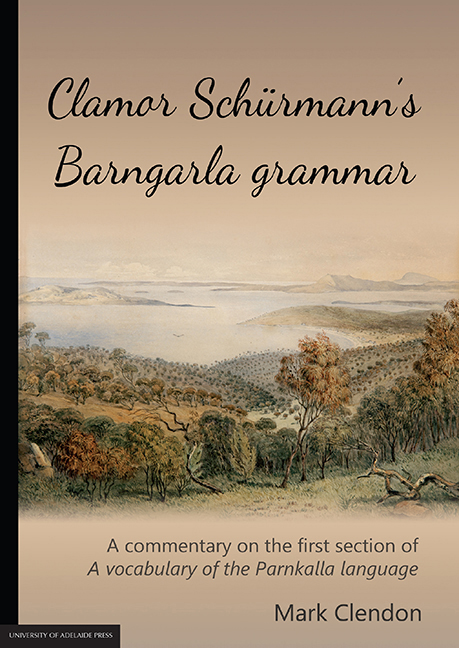 Clamor Schürmann's Barngarla grammar
Clamor Schürmann's Barngarla grammar Book contents
- Frontmatter
- Frontispiece
- Contents
- Abbreviations used in glossing sentence examples & in the text
- Preface
- Map: The northern and western Thura-Yura languages
- 1 Introduction
- 2 Writing Barngarla sounds
- 3 Pronouns
- 4 Intransitive verbs
- 5 Transitive verbs
- 6 Harry Crawford's Barngarla verbs
- 7 Suffixes on nouns
- 8 Other suffixes
- 9 Demonstrative & interrogative pronouns
- 10 Verbal derivational affixes
- 11 Non-finite verbs
- 12 Putting words together
- 13 Prospect
- Appendix The name Barngarla
- References
Preface
Published online by Cambridge University Press: 05 February 2016
- Frontmatter
- Frontispiece
- Contents
- Abbreviations used in glossing sentence examples & in the text
- Preface
- Map: The northern and western Thura-Yura languages
- 1 Introduction
- 2 Writing Barngarla sounds
- 3 Pronouns
- 4 Intransitive verbs
- 5 Transitive verbs
- 6 Harry Crawford's Barngarla verbs
- 7 Suffixes on nouns
- 8 Other suffixes
- 9 Demonstrative & interrogative pronouns
- 10 Verbal derivational affixes
- 11 Non-finite verbs
- 12 Putting words together
- 13 Prospect
- Appendix The name Barngarla
- References
Summary
This commentary on the grammatical introduction to Pastor Clamor Schürmann's Vocabulary of the Parnkalla language of 1844 is designed primarily for educators and other people who may wish to re-present its interpretations in ways more accessible to non-linguists, and more suited to pedagogical practice. It should be seen as one of a number of starting-points for language-reclamation endeavours in Barngarla, and is framed as a component in a Barngarla reclamation project undertaken by the University of Adelaide, and supported by the Commonwealth of Australia.
Grammar is the acoustic-auditory code we use to signal. Language has evolved over the last 1.5 million years at least, and our signals are infinitely varied and extraordinarily complex. Grammar, therefore, could be likened to a mathematical geometry of human cognition. This means that grammar is complex, and Australian languages are as complex as any. Being complex signalling systems, with emotion and culture overlying their geometry, no language is inherently easy for adults to learn; nor is it possible to describe them simply in any interesting detail. While I have tried to make this commentary accessible, it inevitably includes material that is more involved than many non-linguists will wish to take on board at a first reading. It has not been my intention to avoid or skim over difficult or unfamiliar areas of Barngarla grammar, for to do so would be to show scant respect both to Schürmann and to the language itself.
I am indebted to Jane Simpson of the Australian National University for providing me with a copy of Schürmann's vocabulary in an electronic file. This searchable version of the Barngarla vocabulary enabled a more comprehensive appreciation of the language than would have been otherwise achieved. And I am most especially indebted to Luise Hercus for making available her notes on Kuyani, recorded from the last full speaker of that language, and which constitute the most thorough modern documentation we have of any Thura-Yura language.
- Type
- Chapter
- Information
- Clamor Schürmann's Barngarla grammarA commentary on the first section of A vocabulary of the Parnkalla language, pp. xiii - xivPublisher: The University of Adelaide PressPrint publication year: 2015
